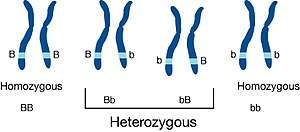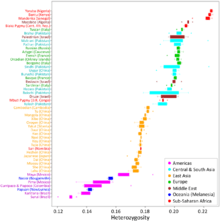Zygosity
Zygosity (the noun, zygote, is from the Greek zygotos "yoked," from zygon "yoke") (/zaɪˈɡɒsɪti/) is the degree to which both copies of a chromosome or gene have the same genetic sequence. In other words, it is the degree of similarity of the alleles in an organism.

Most eukaryotes have two matching sets of chromosomes; that is, they are diploid. Diploid organisms have the same loci on each of their two sets of homologous chromosomes except that the sequences at these loci may differ between the two chromosomes in a matching pair and that a few chromosomes may be mismatched as part of a chromosomal sex-determination system. If both alleles of a diploid organism are the same, the organism is homozygous at that locus. If they are different, the organism is heterozygous at that locus. If one allele is missing, it is hemizygous, and, if both alleles are missing, it is nullizygous.
The DNA sequence of a gene often varies from one individual to another. Those variations are called alleles. While some genes have only one allele because there is low variation, others have only one allele because deviation from that allele can be harmful or fatal. But most genes have two or more alleles. The frequency of different alleles varies throughout the population. Some genes may have alleles with equal distributions. Often, the different variations in the alleles do not affect the normal functioning of the organism at all. For some genes, one allele may be common, and another allele may be rare. Sometimes, one allele is a disease-causing variation while another allele is healthy.
In diploid organisms, one allele is inherited from the male parent and one from the female parent. Zygosity is a description of whether those two alleles have identical or different DNA sequences. In some cases the term "zygosity" is used in the context of a single chromosome.[1]
Types
The words homozygous, heterozygous, and hemizygous are used to describe the genotype of a diploid organism at a single locus on the DNA. Homozygous describes a genotype consisting of two identical alleles at a given locus, heterozygous describes a genotype consisting of two different alleles at a locus, hemizygous describes a genotype consisting of only a single copy of a particular gene in an otherwise diploid organism, and nullizygous refers to an otherwise-diploid organism in which both copies of the gene are missing.
Homozygous
A cell is said to be homozygous for a particular gene when identical alleles of the gene are present on both homologous chromosomes.[2]
An individual that is homozygous-dominant for a particular trait carries two copies of the allele that codes for the dominant trait. This allele, often called the "dominant allele", is normally represented by the uppercase form of the letter used for the corresponding recessive trait (such as "P" for the dominant allele producing purple flowers in pea plants). When an organism is homozygous-dominant for a particular trait, its genotype is represented by a doubling of the symbol for that trait, such as "PP".
An individual that is homozygous-recessive for a particular trait carries two copies of the allele that codes for the recessive trait. This allele, often called the "recessive allele", is usually represented by the lowercase form of the letter used for the corresponding dominant trait (such as, with reference to the example above, "p" for the recessive allele producing white flowers in pea plants). The genotype of an organism that is homozygous-recessive for a particular trait is represented by a doubling of the appropriate letter, such as "pp".
Heterozygous
A diploid organism is heterozygous at a gene locus when its cells contain two different alleles (one wild-type allele and one mutant allele) of a gene.[3] The cell or organism is called a heterozygote specifically for the allele in question, and therefore, heterozygosity refers to a specific genotype. Heterozygous genotypes are represented by an uppercase letter (representing the dominant/wild-type allele) and a lowercase letter (representing the recessive/mutant allele), as in "Rr" or "Ss". Alternatively, a heterozygote for gene "R" is assumed to be "Rr". The uppercase letter is usually written first.
If the trait in question is determined by simple (complete) dominance, a heterozygote will express only the trait coded by the dominant allele, and the trait coded by the recessive allele will not be present. In more complex dominance schemes the results of heterozygosity can be more complex.
A heterozygous genotype can have a higher relative fitness than either the homozygous dominant or homozygous recessive genotype – this is called a heterozygote advantage.
Hemizygous
A chromosome in a diploid organism is hemizygous when only one copy is present.[2] The cell or organism is called a hemizygote. Hemizygosity is also observed when one copy of a gene is deleted, or, in the heterogametic sex, when a gene is located on a sex chromosome. Hemizygosity must not be confused with haploinsufficiency, which describes a mechanism for producing a phenotype. For organisms in which the male is heterogametic, such as humans, almost all X-linked genes are hemizygous in males with normal chromosomes, because they have only one X chromosome and few of the same genes are on the Y chromosome. Transgenic mice generated through exogenous DNA microinjection of an embryo's pronucleus are also considered to be hemizygous, because the introduced allele is expected to be incorporated into only one copy of any locus. A transgenic individual can later be bred to homozygosity and maintained as an inbred line to reduce the need to confirm the genotype of each individual.
In cultured mammalian cells, such as the Chinese hamster ovary cell line, a number of genetic loci are present in a functional hemizygous state, due to mutations or deletions in the other alleles.[4]
Nullizygous
A nullizygous organism carries two mutant alleles for the same gene. The mutant alleles are both complete loss-of-function or 'null' alleles, so homozygous null and nullizygous are synonymous.[2] The mutant cell or organism is called a nullizygote.
Autozygous and allozygous
Zygosity may also refer to the origin(s) of the alleles in a genotype. When the two alleles at a locus originate from a common ancestor by way of nonrandom mating (inbreeding), the genotype is said to be autozygous. This is also known as being "identical by descent", or IBD. When the two alleles come from different sources (at least to the extent that the descent can be traced), the genotype is called allozygous. This is known as being "identical by state", or IBS.
Because the alleles of autozygous genotypes come from the same source, they are always homozygous, but allozygous genotypes may be homozygous too. Heterozygous genotypes are often, but not necessarily, allozygous because different alleles may have arisen by mutation some time after a common origin. Hemizygous and nullizygous genotypes do not contain enough alleles to allow for comparison of sources, so this classification is irrelevant for them.
Monozygotic and dizygotic twins
As discussed above, "zygosity" can be used in the context of a specific genetic locus (example[5]). The word zygosity may also be used to describe the genetic similarity or dissimilarity of twins.[6] Identical twins are monozygotic, meaning that they develop from one zygote that splits and forms two embryos. Fraternal twins are dizygotic because they develop from two separate Oocytes (egg cells) that are fertilized by two separate sperm.
Heterozygosity in population genetics

In population genetics, the concept of heterozygosity is commonly extended to refer to the population as a whole, i.e., the fraction of individuals in a population that are heterozygous for a particular locus. It can also refer to the fraction of loci within an individual that are heterozygous.
Typically, the observed () and expected () heterozygosities are compared, defined as follows for diploid individuals in a population:
- Observed
where is the number of individuals in the population, and are the alleles of individual at the target locus.
- Expected
where is the number of alleles at the target locus, and is the allele frequency of the allele at the target locus.
See also
- Heterosis
- Heterozygote advantage
- Loss of heterozygosity
- Nucleotide diversity measures polymorphisms on the level of nucleotides rather than on level of loci.
References
- Carr, Martin; Cotton, Samuel; Rogers, David W; Pomiankowski, Andrew; Smith, Hazel; Fowler, Kevin (2006). "Assigning sex to pre-adult stalk-eyed flies using genital disc morphology and X chromosome zygosity". BMC Developmental Biology. Springer Nature. 6 (1): 29. doi:10.1186/1471-213x-6-29. ISSN 1471-213X. PMC 1524940. PMID 16780578.
- Lawrence, Eleanor (2008). Henderson's Dictionary of Biology (14th ed.).
- Lodish, Harvey; et al. (2000). "Chapter 8: Mutations: Types and Causes". Molecular Cell Biology (4th ed.).
- Gupta, Radhey S.; Chan, David Y.H.; Siminovitch, Louis (1978). "Evidence for functional hemizygosity at the Emtr locus in CHO cells through segregation analysis". Cell. Elsevier BV. 14 (4): 1007–1013. doi:10.1016/0092-8674(78)90354-9. ISSN 0092-8674.
- Pujol, C.; Messer, S. A.; Pfaller, M.; Soll, D. R. (2003-04-01). "Drug Resistance Is Not Directly Affected by Mating Type Locus Zygosity in Candida albicans". Antimicrobial Agents and Chemotherapy. American Society for Microbiology. 47 (4): 1207–1212. doi:10.1128/aac.47.4.1207-1212.2003. ISSN 0066-4804. PMC 152535. PMID 12654648.
- Strachan, Tom; Read, Andrew P. (1999). "Chapter 17". Human Molecular Genetics (2nd ed.).
- López Herráez, David; Bauchet, Marc; Tang, Kun; Theunert, Christoph; Pugach, Irina; Li, Jing; et al. (2009-11-18). Hawks, John (ed.). "Genetic Variation and Recent Positive Selection in Worldwide Human Populations: Evidence from Nearly 1 Million SNPs". PLoS ONE. Public Library of Science (PLoS). 4 (11): e7888. doi:10.1371/journal.pone.0007888. ISSN 1932-6203. PMC 2775638. PMID 19924308.
External links
